Since its opening in 1995, the Yokote Masuda Manga Museum has been actively involved in the collection of original manga drawings. With an emphasis on the preservation and use of original drawings, the museum was renovated and reopened in 2019. The field of manga in general is still in the process of reconciling opinions within the industry on how to deal with historical materials of original manga works, which are in danger of being lost or scattered. The Yokote Masuda Manga Museum has been a pioneer in the field, from collecting to preservation and utilization. We interviewed OISHI Takashi, the museum’s director.
 The Masuda-machi Manga Museum was opened in 1995, in a corner of the Masuda Fureai Plaza complex. In 2019, it reopened as the Yokote Masuda Manga Museum, a stand-alone manga facility. Adjacent to the museum, the streets of Masuda, known as the “town of Uchigura,” were selected as Japan’s “Important Preservation District for Groups of Traditional Buildings” in 2013.
The Masuda-machi Manga Museum was opened in 1995, in a corner of the Masuda Fureai Plaza complex. In 2019, it reopened as the Yokote Masuda Manga Museum, a stand-alone manga facility. Adjacent to the museum, the streets of Masuda, known as the “town of Uchigura,” were selected as Japan’s “Important Preservation District for Groups of Traditional Buildings” in 2013.
Why was it necessary to archive original drawings that were once considered worthless?
There will be a day, perhaps in years from now, when curious people may know that manga used to be drawn on paper with ink. Half a century ago, it would have been hard to believe that the original drawings of manga would be framed and displayed in museums. The position of original works has changed over time.
An original is a printing plate in the process of printing. In that sense, it is an intermediate product. For this reason, there was a time when it was not always guaranteed that the original work was returned to the manga artist by the publisher. Even when they were returned, it was not uncommon for them to be discarded in closets, left untouched in trunks or even as rubbish, without any intention on the part of the manga artists to keep them. It is safe to say that this has been the case for a long period of manga history.
What is the value of an original drawing? The pictorial value is immediately obvious. But if we look outside the panels, we can’t overlook the value of the material that traces the production process, such as the tone instructions penciled by the manga artist to his/her assistants or editors’ notes. It was not until exhibitions of original works began to be held in museums and exhibition spaces at department stores that their cultural, as well as economic, value came to be recognized by the public (*1). In particular, the economic value of original drawings has been increasing in recent years with auctions and other sale forms, and awareness toward the value of original artworks has been changing.
Major institutions working on the conservation of original drawings and their years of opening are: the Kitakyushu Manga Museum in 2012, the Kyoto International Manga Museum in 2006, the Yoshihiro Yonezawa Memorial Library of Manga and Subcultures (Meiji University Modern Manga Library) in 2009 (*2), and the Yokote Masuda Museum of Manga in 1995. The tide of public awareness toward manga culture can be seen to have turned approximately in the late 1990s.
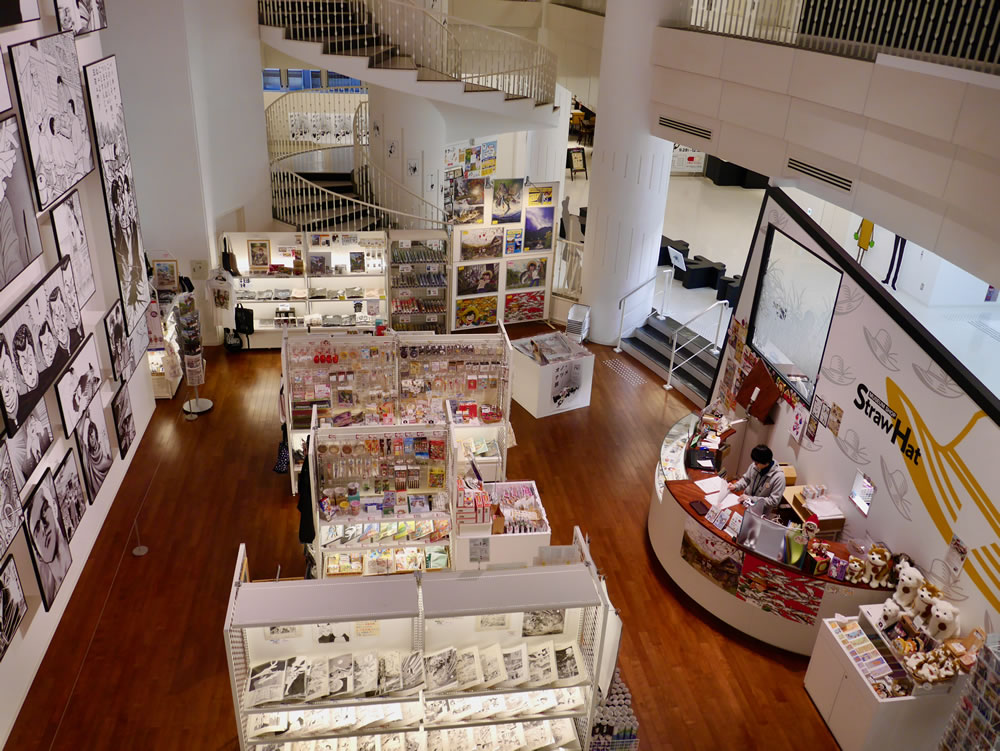 A museum shop. The 10m high wall on the left called Manga Wall is covered with famous manga scenes.
A museum shop. The 10m high wall on the left called Manga Wall is covered with famous manga scenes.
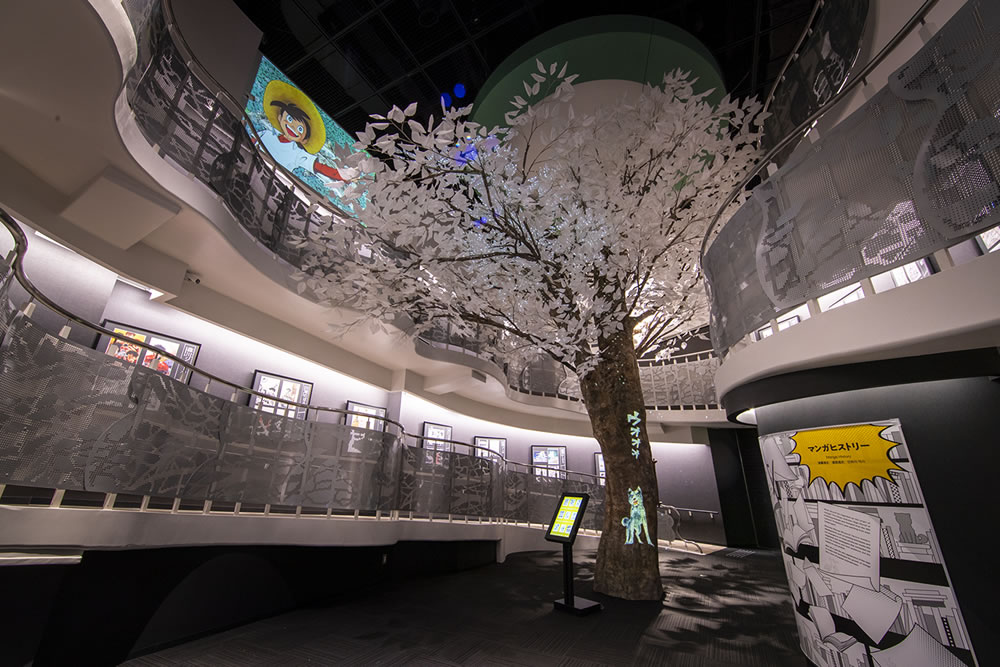 The permanent exhibition room, accessed via a slope leading to the second floor. The room contains original drawings by 74 artists and are regularly replaced by works of more than 100 artists from the museum collection.
The permanent exhibition room, accessed via a slope leading to the second floor. The room contains original drawings by 74 artists and are regularly replaced by works of more than 100 artists from the museum collection.
A strong will to archive made clear by the 2019 renewal
The Yokote Masuda Museum of Manga opened in 1995, specializing in the exhibition of original drawings. Its focus was on the collection of original drawings by local manga artist YAGUCHI Takao (*3). Since 2015, the museum has added the collections of tens of thousands of original drawings by TAKAHASHI Yoshihiro, KOJIMA Goseki, NOJO Junichi, TSUCHIYAMA Shigeru, HIGASHIMURA Akiko, and KURATA Yoshimi. The number of manga artists has increased (*4), and in 2019, the museum reopened as a major project of the “Akita Prefecture shi cho son mirai zukuri kyodo program Yokote City Project (Akita Prefecture collaborative program for building the future of municipalities, Yokote City Project).”
What changed before and after the renovation? Actually, the floor space was not increased during the two years of construction, and the building’s layout has remained almost unchanged. The renovation was mainly to upgrade the functions of the old layout of the building, which used to be a community center, such as turning a meeting room into an exhibition space, a cooking area into a café, and a regular library into a manga library. One major change is visible: the creation of a glass-walled storage room for original drawings. In this room, you can feel the intention and message of the original drawing archive. The museum has taken a step forward from the exhibition of original drawings to make archiving original drawings a major pillar of the museum, and has made this clear to visitors.
The “Manga no Kura,” a glass-walled room for storing original drawings, has a plaque indicating which manga artists’ original drawings are currently being maintained and stored, and visitors can see the archiving process up close. OISHI Takashi, a former Yokote City employee, who currently serves as the director of the Yokote Masuda Manga Museum, explains the concept of this space.
“The theme for the government was to create a sense of civic pride so that citizens would get a sense of pride from the public funds spent to house the collection. I thought that there was no better way to convey how the original works of manga artists, who have supported Japanese culture, were being stored with such care in a local museum than to have people actually see them. That’s what visualization is all about. When citizens come to the museum, they don’t understand that the original drawings are stored in a closed storage room and are ‘off-limits.’”
This “show-and-tell” collection is similar to a backyard tour at a museum, where items not usually seen are open to the public. Moreover, opening periods are not limited but can be viewed any time (*5). It is also important to note that the processes that can be seen in this room are not just part of the archiving process, but the entire archiving process from ledger entry to digitization. Visitors can witness the actual process of archiving and see and feel the amount of energy and time that goes into the collection process. It can be said that this space is the museum’s greatest exhibition.
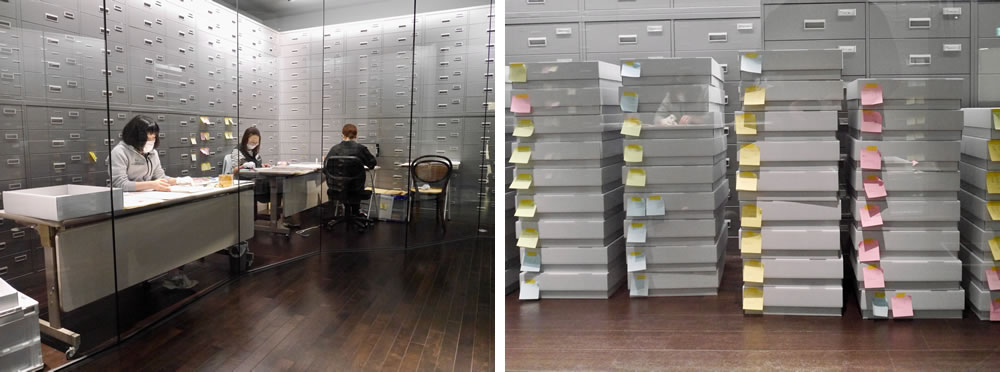 In the “Manga no Kura,” there is an archive room for digitizing original drawings and a storage room for storing and managing original drawings. Both are visible behind glass.
In the “Manga no Kura,” there is an archive room for digitizing original drawings and a storage room for storing and managing original drawings. Both are visible behind glass.
A process that was created where there were no roads
The archiving process is roughly divided into the following steps:
(1) Comparing the original with the first published book (*6)
(2) Entering in the ledger
(3) Scanning
(4) Inserting acid-free paper material into the original
(5) Inserting each story into an acid-free paper envelope
(6) Placing each volume in an acid-free paper box
What surprised me was that all of these methods of organization were developed on their own. In the first place, since there is no qualification for “curator specializing in manga” in Japan, museum staff members and people involved had no choice but to explore how to preserve the original drawings. While hearing from curators of nearby museums and prefectural facilities about the “rules and behavior” of handling works on paper, they accumulated knowledge about, for example, the use of acid-free paper to prevent acidification of the paper, and solidified the rules for the original drawings one by one.
There was no standard resolution for digitization. The museum has set 1,200 dpi, but of course, the higher the resolution, the better, and there is no limit to how high the resolution can go when assuming permanent preservation (*7). The museum officials tentatively decided on this value while balancing the possibilities of data utilization, the time required for scanning, and data capacity. There was also a certain dilemma involved.
“Scanning at higher resolutions takes more time and data space (*8). Making multiple backups of the data further increases hard-disk costs. In other words, storage accuracy is directly related to the cost issue,” OISHI says.
While the purpose of this activity is to recognize and promote the cultural value of the original drawings, the drawings’ volume is too enormous to treat them on a par with works of art. It is important to maintain a balance.
“If you try to treat (a drawing) like a painting or other work of art, it would require a tremendous amount of time, money, and manpower. For that reason, no one would be able to work on it. Therefore, we tried to find a way of archiving that is suitable for the original drawings without being overwhelmed. If we try to do it carefully, we end up with too many opinions and we can’t decide. So, if I may say so, it was necessary to ‘start moving.’”
There are no qualifications for working in the archives at the moment. There is no need to be knowledgeable about the works handled. The only requirement is to be prepared to “handle the work with the understanding that it is an important piece of work that cannot be replaced.” What we need to work on now is how to organize and protect what we have in front of us. A sense of speed is important, as we are dealing with paper and ink that deteriorate day by day.
The archiving methods established by the museum have been shared at the Media Arts Collaboration Promotion Projects. They were compiled as the “archive manual for original drawings of manga (in Japanese)” in fiscal 2019. The creation of rules involving facilities nationwide is steadily moving forward.
In the second part of the article, we introduce the museum’s efforts related to utilizing the original artworks, which go beyond the archive.
[Procedure for archiving original drawings]
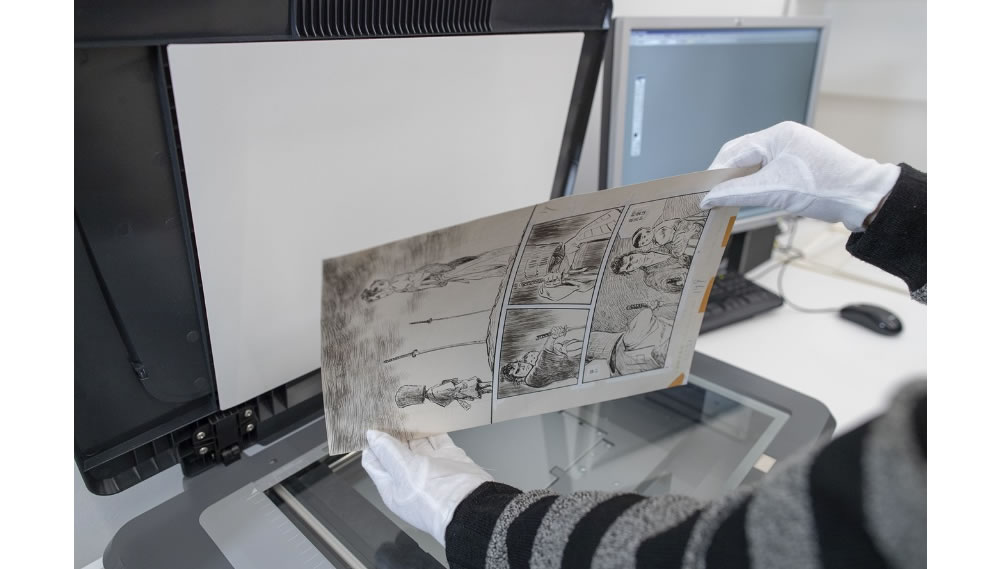 Scanning the original at 1,200 dpi resolution after entering the original’s status in the original ledger.
Scanning the original at 1,200 dpi resolution after entering the original’s status in the original ledger.
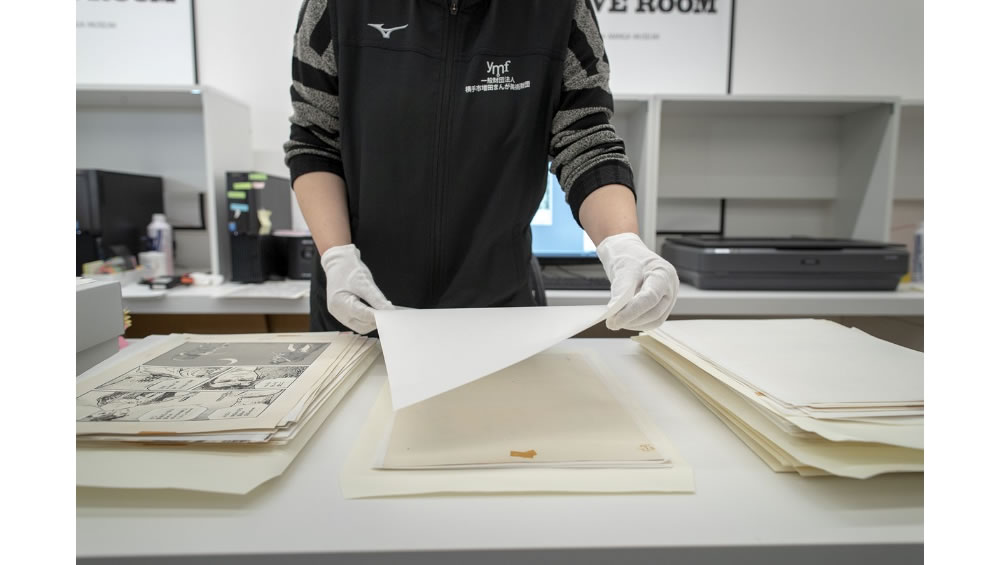 Placing an acid-free interleaving paper between the original drawings. This prevents the paper from deteriorating and the original drawings from adhering to each other.
Placing an acid-free interleaving paper between the original drawings. This prevents the paper from deteriorating and the original drawings from adhering to each other.
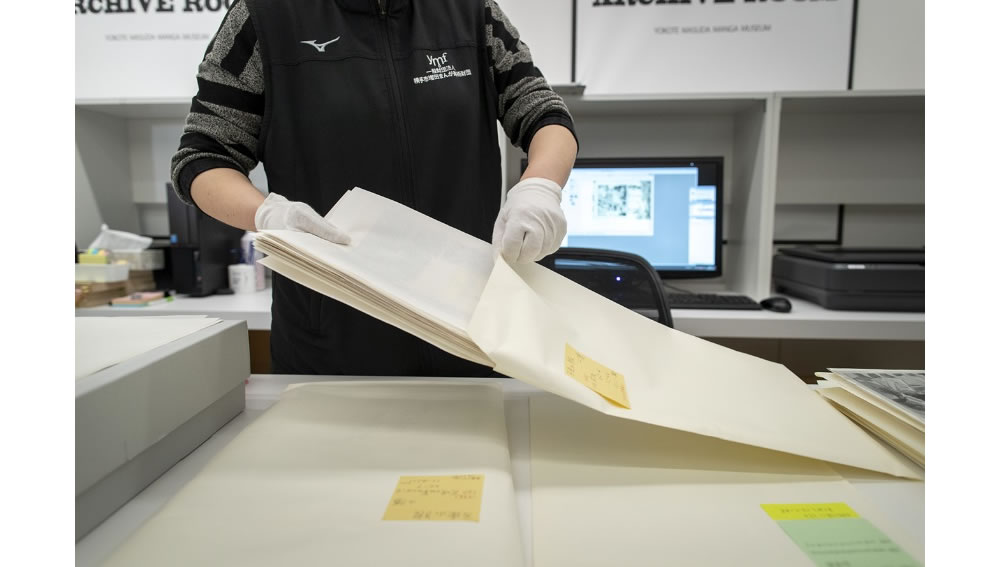 Inserting interleaving paper into the original for one story and then placing it in an acid-free paper envelope. Affixing an administrative sticker on the envelope, showing the work’s name and ID.
Inserting interleaving paper into the original for one story and then placing it in an acid-free paper envelope. Affixing an administrative sticker on the envelope, showing the work’s name and ID.
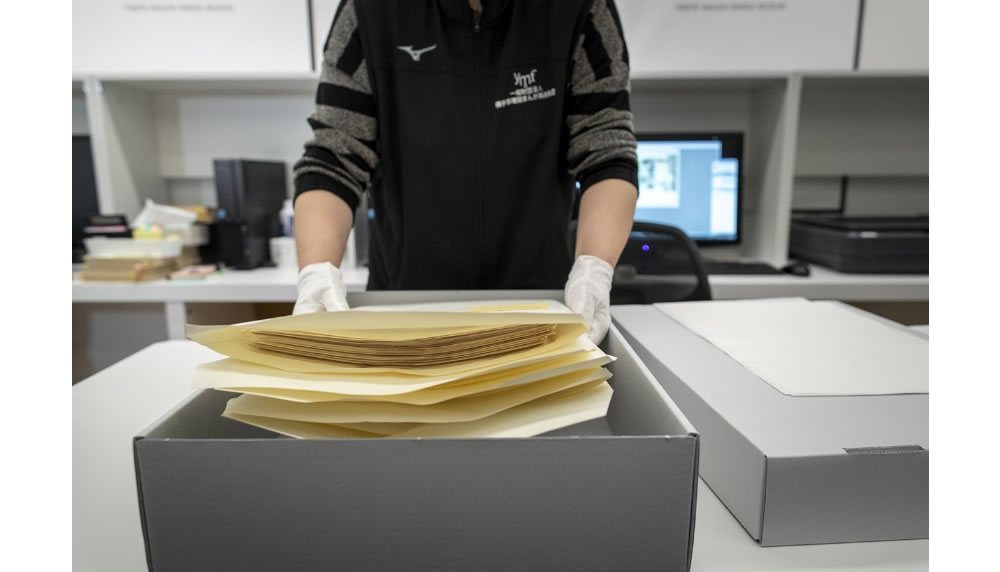 After each story is placed in an envelope, each volume is put in a box made of acid-free paper material. A sticker for administrative purposes is affixed to the box, and the box is stored in a room where the temperature and humidity are optimal.
After each story is placed in an envelope, each volume is put in a box made of acid-free paper material. A sticker for administrative purposes is affixed to the box, and the box is stored in a room where the temperature and humidity are optimal.
(notes)
*1
In 1990, the year following TEZUKA Osamu’s death (1989), the first major exhibition on manga was the “Showa no Manga Exhibition” (Exhibition of Manga in the Showa Era) (at the Kawasaki City Museum, etc.). In the same year, the “Osamu Tezuka Exhibition” (at the National Museum of Modern Art, Tokyo, etc.) was held with 1,500 pages of original drawings. The number of exhibitions of individual manga artists held at public art museums has increased significantly since the 2000s, with the “The World of Akira Toriyama” exhibition held at the Kawasaki City Museum in 1993, followed by the “Kyoko Okazaki Exhibition” at Gallery P-House in 1994.
*2
Japan’s first manga library opened in 1978, based on the collection of NAIKI Toshio. The collection was donated to Meiji University in 2009. In March 2021, the library was relocated from Shinjuku-ku, Tokyo, to the university’s Surugadai campus, where it is integrated with the Yoshihiro Yonezawa Memorial Library of Manga and Subcultures. The largest collection of books and materials in Japan comprises 410,000 items.
*3
He served as the honorary director of the museum after its opening and passed away in November 2020. His representative works include Tsurikichi Sanpei (Fisherman Sanpei) (serialized in Weekly Shonen Magazine and Monthly Shonen Magazine from 1973 to 1983).
*4
As of May 2021, the number of artists with large collections had further increased to include SAITO Takao, URASAWA Naoki, and YAKU Mitsuru.
*5
The archive work continues to operate in shifts, except on the third Tuesday of each month.
*6
Because color and black-and-white drawings are printed separately, they are returned at different times. In many cases, the manga artists are not able to keep them in order. “Sometimes we encounter items in which the first four color pages are missing. At other times, a page is left on loan at an exhibition and cannot be found. That’s why cross-checking is the first and most important step,” OISHI said.
*7
The 400 dpi resolution for ordinary printed matter and 300 dpi for monochrome manga magazines are common. However, for archive activities, 400 dpi is insufficient for the purpose of producing original reproductions or panels that have been enlarged for exhibitions. Therefore, the museum decided on a resolution of 1,200 dpi for importing with a flood head scanner, referring to the resolution of photo collection books and centerfold pages. As you can see, the resolution setting for scanning depends on the item’s subsequent use and purpose. The Meiji University Manga Library uses an overhead scanner at 300 dpi, while the Kitakyushu Manga Museum uses a flood head scanner at 600 dpi.
*8
At 1,200 dpi, the data capacity per original drawing is about 700 MB.
(information)
Yokote Masuda Manga Museum
Address: 285 Masuda Aza Shinmachi, Masuda-machi, Yokote, Akita
Open Hours: 10:00–18:00
Closed: Third Tuesday of the month (If it is a national holiday, then the following day.)
Admission: Free for permanent exhibitions (Fees required for special exhibitions)
http://manga-museum.com
*URL links were confirmed on June 16, 2021.











